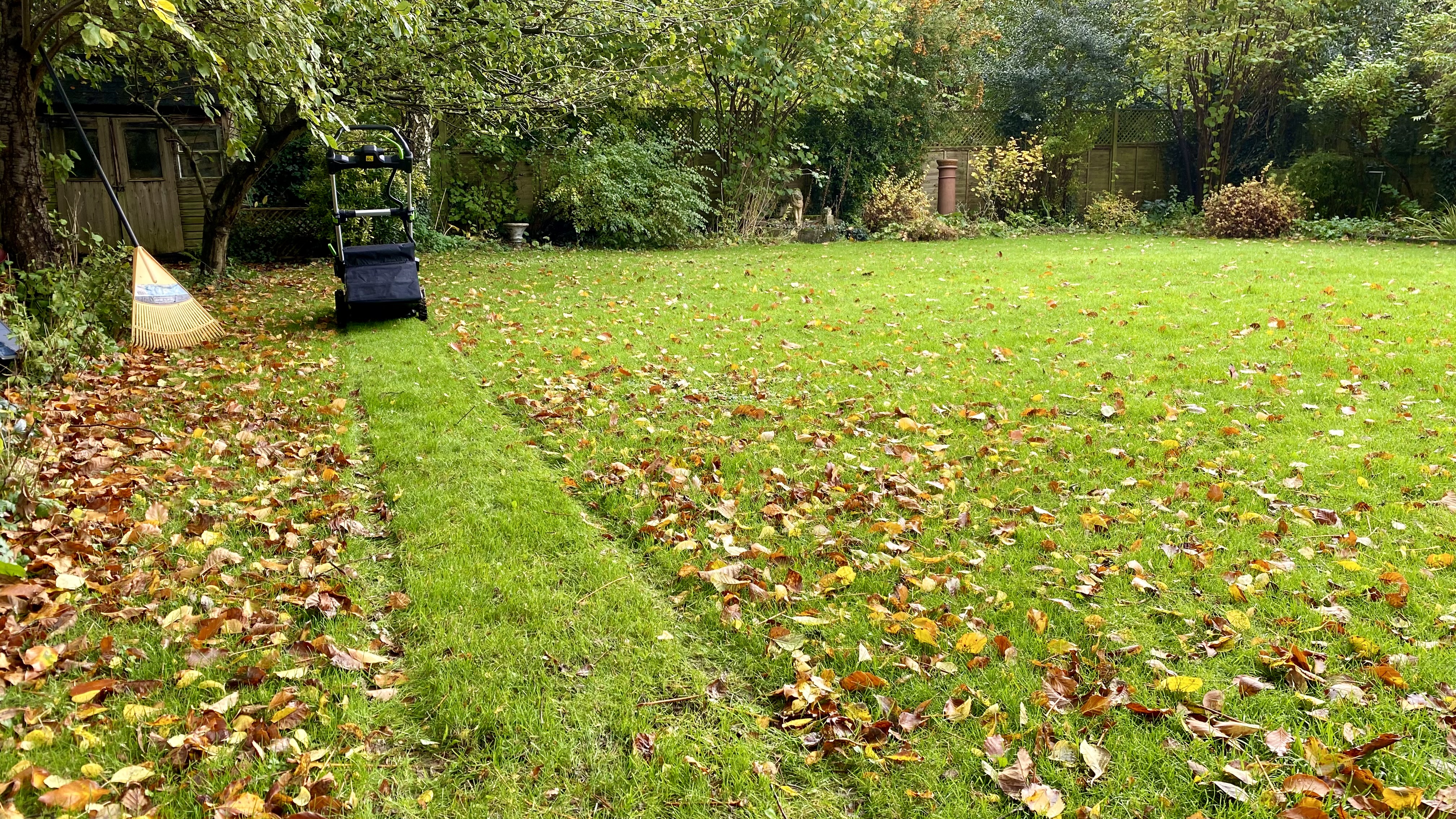
As the golden hues of autumn foliage begin to fade and leaves start piling up on the lawn, it may seem tempting to retreat indoors and neglect the sward until the arrival of spring. But this is a bad thing if you want a lush, healthy and verdant lawn come springtime.
Autumn and winter provide a great window of opportunity for nurturing your lawn and ensuring it thrives when the sun pops out again. By taking proactive steps during autumn and winter, you can lay the groundwork for a resilient lawn that will be the envy of your neighbourhood.
In this guide, we'll explore the essential steps and strategies for preparing your lawn during the colder months, helping you achieve a landscape that's not only beautiful but also well-prepared for the challenges that will inevitably follow during the next growing season.
1. Remove leaves on the lawn

While foliage looks beautiful in autumn, it can get very a messy once the leaves start falling. So, if you have loads of trees around the garden like I do, the first battle of the season is to get rid of the inevitable deluge that litters the lawn. This is important because clearing lawn leaves will help the lawn breathe better and prevent the buildup of thatch that can smother your grass and make it more susceptible to pests and diseases. And, besides, leaves make the lawn look sad and unsightly.
There are several methods you could use for leaf extraction and chief among these is the best leaf blower. So grab your cordless beast and blast the leaves towards some hard ground where they’re easier to sweep up using a wide outdoor broom or, if you fancy spending more, a Kärcher Push Sweeper.
Alternatively, you could try raking the lawn with a wide grass rake. This scarifies the grass in the process, removing thatch at the same time. (You can read about scarifying in our guide to making your lawn look spectacular). However, raking leaves off a lawn is one of the most time- and energy-intensive garden activities and it’s often frustrating, too, because there will always be some obstreperous leaves that refuse to budge.
And that brings us to the most effective leaf removal solution of all – the best lawnmower. I‘ll get to mowing the lawn in the next chapter but stay here for a minute while I tell you why a lawnmower is the very best way to remove lawn leaves en masse.

By their design, the best electric, cordless and petrol lawnmowers create a sort of vortex as the blades spin at a great rate of knots. Hence, they not only cut the grass, but the clippings are sucked up at the same time and deposited into the grass collector. Amazingly, this same process occurs with leaves. And not only that, but the leaves are actually mulched by the fast spinning blades so more leafy detritus can be fitted into the grass collector. See the above image for proof.
Simply raise the height of the cutting deck so the mower’s blades just trim the top centimetre or so of the grass and mow over the leaves. I’d say that about 95% of leaves can be collected in this way and you can see the instant results by simply looking behind you. Once the grass collector is full, empty the contents on your compost heap and repeat the process until the lawn looks almost totally leafless. Then go around and collect the few remaining leaves by hand. Of course, you’ll need to do this every few days during autumn but whoever said gardening was easy?
2. Mow the lawn

Once winter sets in it shouldn’t be necessary to mow the lawn. In fact it’s not really advisable because the grass will be wet from rain or covered in dew almost every hour of the day... and wet grass doesn’t cut well. However, it is a good idea to at least try and get a mowing session in before the end of autumn. As mentioned above, you could kill two birds with one stone and cut the lawn to a height of two-to-three inches while collecting leaves at the same time. Job’s a good ‘un.
3. Maintain your lawn mower

Autumn and winter are also a good time to do some lawnmower maintenance. Thankfully, the best cordless lawnmowers don’t require any TLC though this period would be a good time to either take the blades in for resharpening or replacing them altogether.
It’s an altogether different kettle of fish if you have a petrol lawnmower because these lawn beasts do need some TLC. One of the most important things you should do come winter is syphon off the unleaded fuel in the tank or it will absorb moisture over the winter months and play havoc with the mower’s carburettor. This could not only make your mower difficult to start the following spring, but chances are the engine will suffer from surging where the revs go up and down. Since pump fuel goes off after a few months anyway, empty the mower’s tank and take the fuel to your local municipal refuse dump for safe disposal.
Now, do not skip this next section because what I’m about to tell you will save you all the bother of emptying petrol tanks and save you a lot of money in the long term by not having to book the mower in for a carburettor service. Forecourt fuel has ethanol in it and ethanol is hygroscopic, which means it attracts and absorbs moisture like a sponge. And that in turn eventually results in water and ethanol being sucked into the fuel system causing components like the carburettor to fail. It also leads to poor engine starting and running issues.
One of the easiest courses of action is to add a fuel additive or stabiliser every time you top up your fuel can. This won’t remove the ethanol but it will coat the engine’s internals with a protective barrier, helping it to run more smoothly. It will also increase the life of the petrol itself, whether it’s stored in the shed or in the mower’s tank.
However, there is another fuel solution which I recently learned about from a reputable lawn mower engineer. It’s called Aspen and it’s available for both four-stroke and two-stroke engines. Aspen is an ethanol-free alkylate fuel that contains 99% fewer harmful hydrocarbons, which results in a dramatic reduction of exhaust fumes. It also lasts for up to five years in storage! This is great news for the environment and your health but it’s also much better for your lawn mower’s engine. So scrap the forecourt petrol and give Aspen a whirl. You will thank me later for this.
4. Aerate the lawn

Aeration is the foundation of a well-maintained lawn because it helps to loosen compacted soil, which allows water and air to penetrate the root zone more easily. Unfortunately, aeration is even more time and energy intensive than collecting leaves. In fact it’s more energy intensive than running the Marathon des Sables.
There are three main ways to aerate a lawn and the cheapest but most exhausting method is to use the best garden fork to punch holes about four to six inches deep into the soil at regular intervals. For maximum effect it’s best to stomp on the fork and wiggle it back and forth a bit so the soil is loosened beneath the surface. However, if you have a big lawn, chances are you’ll give up on this method after about 10 minutes and start searching online for a more useful solution. One of these is the Draper Rolling Lawn Aerator which is essentially a spiky roller than makes small holes in the lawn as you push or pull it along. Although this is one of the easiest methods, it’s not very useful on hard ground because the spikes simply won’t penetrate. Hence, it’s best used during damp weather when the ground is soft enough.
Another unusual but bizarrely effective method is to invest in a pair of lawn aerator strap-on sandals. Simply strap the spiked sandals to your best garden boots and stomp up and down the lawn. Yes, you’ll look like a plonker but, hey, the grass will thank you for it.
5. Add extra seed

Autumn is an ideal time for overseeding your lawn since the cooler temperatures and increased moisture create optimal conditions for grass seed germination and establishment. Whether you're looking to repair bare patches or thicken existing grass, the autumn season provides the perfect opportunity to achieve a lush, healthy lawn for the upcoming year. Simply purchase a box of suitable autumnal seed like ColdStart from Garden Lawncare Guy and spread it evenly over the lawn, taking care to add a bit more seed to the barest patches.
6. Feed the lawn
An application of autumnal lawn fertiliser will help your grass to store up nutrients, which will help it to survive better through the winter. I recommend Miracle-Gro Autumn Lawn Care since it strengthens roots and kills moss effectively. The best time to fertilise the lawn is by mid autumn when the grass is still actively growing. Avoid late autumn and winter applications as they may encourage excessive growth that could be damaged by harsh winter conditions. Also be sure to follow the manufacturer’s instructions and go easy on the application or you may overdo it. Follow up with a sprinkle of water or apply the fertiliser just before it’s due to rain.







